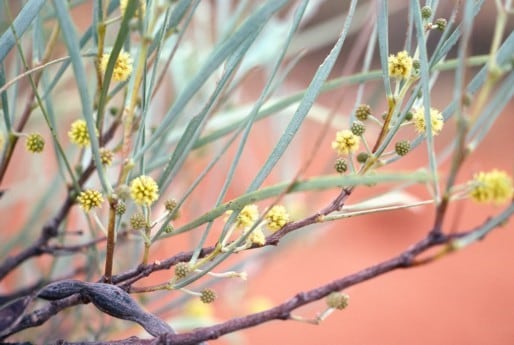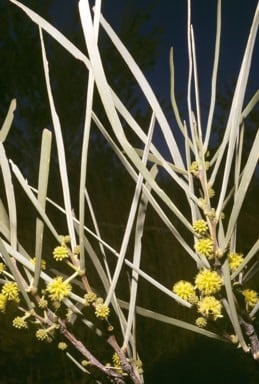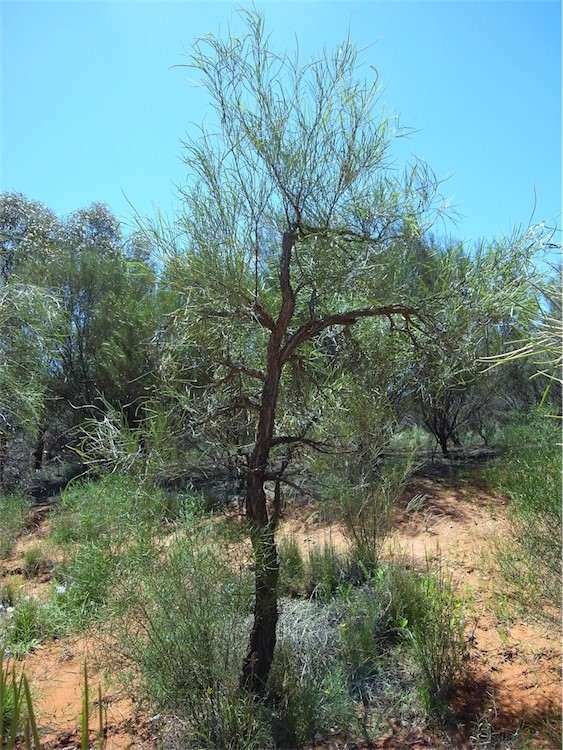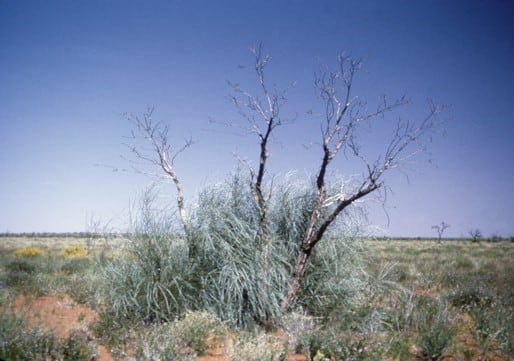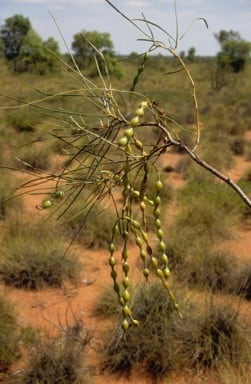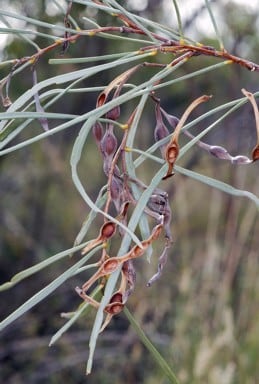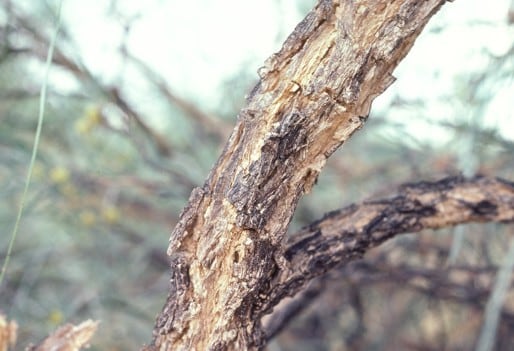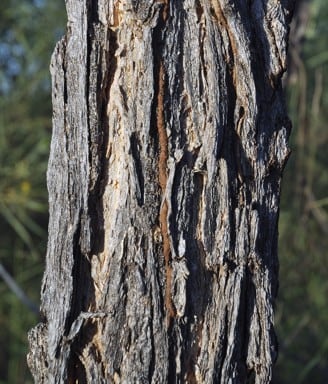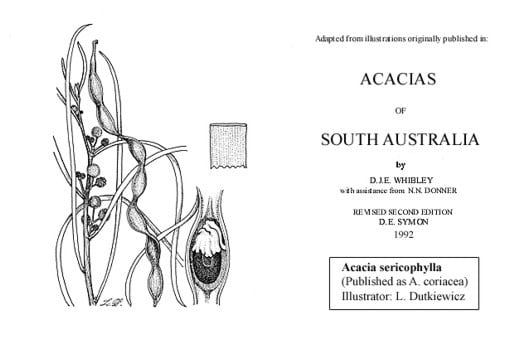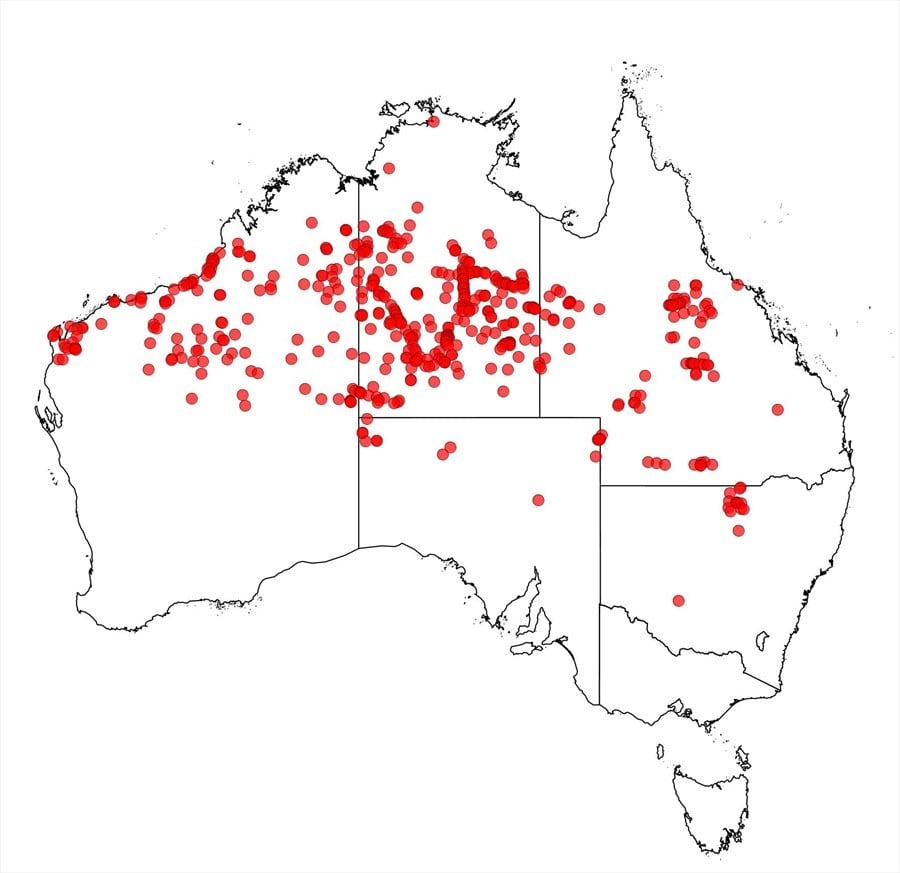Acacia sericophylla F.Muell.
WATTLE
Acacias of Australia
Common Name
Desert Dogwood, Desert Oak, Dogwood, Wirewood
Family
Fabaceae
Distribution
Widespread across northern central arid zone from W.A. through N.T. and S.A. to Qld and N.S.W. In N.S.W. it is restricted to the Cumborah and New Angledool areas.
Description
Tree 3–10 m high, shrubby, normally somewhat gnarled. Bark thick and corky, yellow and spongy, internally. Branchlets not pendulous, silvery sericeous. New shoots sericeous, pale yellow. Phyllodes linear, often pendent, flat or ±terete, (12–) 15–30 (–35) cm long, 1–4 (-7) mm wide, silvery grey-green to ±glaucous or sometimes green, densely and minutely sericeous when young but sub-glabrous with age; finely multistriate; gland not prominent, (0–) 2–8 (–10) mm above pulvinus. Inflorescences mostly simple and in pairs, sometimes 1- or 2-headed rudimentary racemes 0.5–4 (–10) mm long; peduncles (8-) 10–20 (-30) mm long, sericeous; heads globular, 15-50-flowered, pale lemon yellow. Flowers 5-merous; sepals ½-3/4-united. Pods moniliform, straight to shallowly or strongly curved before dehiscence, not markedly twisted or coiled, to 34 cm long, 5-12 mm wide, coriaceous to ±woody, longitudinally nerved, densely silvery sericeous but indumentum sparser on oldest pods. Seeds longitudinal, broadly elliptic, 4-8 mm long, glossy, black; aril large, partially sheathing seed, yellow or orange.
Habitat
Grows in red sand and sandy or pebbly loam, mostly in open shrubland over spinifex.
Specimens
W.A.: Cape Keraudren, B.R.Maslin 4864 (CANB, PERTH); 45 km NE of Whim Ck on North West Coastal Hwy, B.R.Maslin 5255 (PERTH). N.T.: 29 km N of Tanami, J.R.Maconochie 1729 (DNA, PERTH). S.A.: N side of Mt Lindsay, D.J.E.Whibley 6629A (AD); Lake Eyre region, Marqualpie Paddock, Innamincka Stn, J.Reid 1635 (AD). Qld: 32 km E of Hughenden Township, N.H.Speck 4527 (NSW, PERTH); Barcaldine, Mitchell District, C.T.White 12348 (BRI). N.S.W.: E of Cumborah, P.L.Milthorpe 3827 & G.M.Cunningham (NSW).
Notes
This species was treated as A. coriacea subsp. sericophylla by R.S.Cowan & B.R.Maslin in Fl. Australia 11B: 105-106 (2001) but is now reinstated to species status, fide B.R.Maslin & S.vanLeeuwen, Nuytsia 18: 149 (2008).
A drought-tolerant, long-lived species with seemingly a slow or moderate growth rate. The thick bark and ability to coppice from the base (and to regenerate by root suckers) make this a very fire-tolerant species. Although the phyllodes and pods are sometimes eaten by stock in Central Australia and Queensland, they are relatively unpalatable and of only moderate nutritional value. As reported by P.Latz, Pocket Bushtucker: a field guide to the plants of Central Australia and their traditional uses 154 (1999) the seeds of this species are an important source of food for traditional Aborigines of Central Australia.
Closely related to A. coriacea which differs most obviously in having thin, fibrous and longitudinally fissured bark, generally shorter peduncles and pods (prior to dehiscence) markedly and often irregularly curved, twisted and/or openly coiled. Furthermore, subsp. coriacea commonly grows on coastal dunes, subsp. pendens grows inland from the coast, normally along water courses, while A. sericophylla prefers ‘spinifex’ sandplains. Also has affinities to A. sibilans and has sometimes been confused in some regions with A. calcicola.
Sterile plants of A. sericophylla can be confused with Hakea lorea subsp.lorea (‘Cork Tree’ which has thick corky bark) or Grevillea striata (‘Beefwood’); these species can have a superficially similar growth form and long foliage, and all three occur in the Pilbara region. Acacia sericophylla is most reliably distinguished by its phyllodes which possess a pulvinus and a small gland on the upper margin.
FOA Reference
Data derived from Flora of Australia Volumes 11A (2001), 11B (2001) and 12 (1998), products of ABRS, ©Commonwealth of Australia
Author
Revised by B.R.Maslin & J.Reid
R.S.Cowan, B.R.Maslin
This identification key and fact sheets are available as a mobile application:
URL: https://apps.lucidcentral.org/wattle/
© Copyright 2018. All rights reserved.
